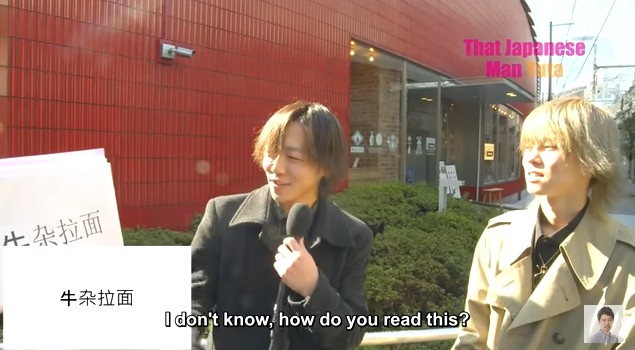
My previous post received a lot of interesting comments from Journalers, which motivated me to write more about the Chinese and Japanese languages.
Simplified and traditional Chinese characters
Balagi shared an interesting video on YouTube, where a YouTuber named Yuta is quizzing Japanese people on the street on Chinese phrases. This is the simplified Chinese version.
https://www.youtube.com/watch?v=rzJqXd-1dEU
I watched the traditional Chinese version, too.
https://www.youtube.com/watch?v=-E6vHCT0wpw
In both videos, the first item in the quiz is "beef offal ramen".

Shown traditional characters, the majority of Japanese people answer correctly. And that's no surprise because 牛 and 麺 have the same meaning in both languages. In Japan, ramen is normally written ラーメン, using katakana (a syllabary which can be used like an alphabet in the place of Chinese characters), but we occasionally see its Chinese characters 拉麺 on signboards or ramen packaging. In Japan, 雑 has different meanings from offal, but not so far off that one couldn't guess it. On the other hand, simplified Chinese characters aren't that easy for us because they're quite different from our own. However, now I know one of the principles of simplification: some of them replace the more complicated traditional character with components of that character. As such, I'm now able to guess what the traditional character was based on the simplified character.
Importance of context
In my previous post, I wrote that the reason I can work out practically everything on the menu in Chinese restaurants is that both languages share a lot of the same food-related words. However, when I was writing that post, I completely forgot the most significant reason: context. Most Japanese people would be able to make out the words 牛雑拉麺 if they were on a menu rather than in a street quiz. The same goes for 牛杂拉面, despite its little difficulty.
Sound and grammar
As I mentioned in my previous post, the sounds of the two languages are completely different. Learning to listen and speak Chinese would be difficult for us Japanese speakers. In addition to that, their grammars also differ greatly from one another. The word order in Chinese is closer to English than to Japanese. For us Japanese, Korean is far more familiar than Chinese in these two areas. I know very little about Korean, but people say the grammar is comparable to Japanese, and I can hear and mimic practically all Korean sounds. The Japanese dialect of Fukuoka is said to sound especially similar to Korean. Fukuoka Prefecture is located in southern Japan, and much closer to Busan, Korea, than Tokyo.
Kango as borrowed words
Having said that, I noticed certain words in the videos that have similar consonants to their Japanese counterparts. 图书馆 (library) and 太阳 (the sun) are two of those. I guess they're originally from China. These kinds of words are called 漢語 kango (Chinese words), but we aren't usually aware of them as borrowed words because they were introduced into our culture too long ago. Sometimes, we're not even sure which words are kango and which are native Japanese.
--
There'll be a part 2!
Excited for part 2!
Glad to see Yuta's videos being put to good use! I used to watch a lot of his street interviews some time ago.
Very interesting!
@hdrx @Sunflower1234 I appreciate you taking the time to read such a poorly written post!
@BalaGi Yuta's channel is interesting!
@CocoPop Thank you, as always! I'll thoroughly evaluate this post and analyze the corrections.
You're always welcome! It was a great post with lots to learn. Let me know if you have any questions.
Poorly written?! I aspire to write my Japanese posts the way you write yours, they are very enjoyable to read!
@CocoPop I found it challenging to write about languages in English, but your corrections made it worthwhile!
@hdrx Thanks for the kind words! I always enjoy reading your Japanese posts too!